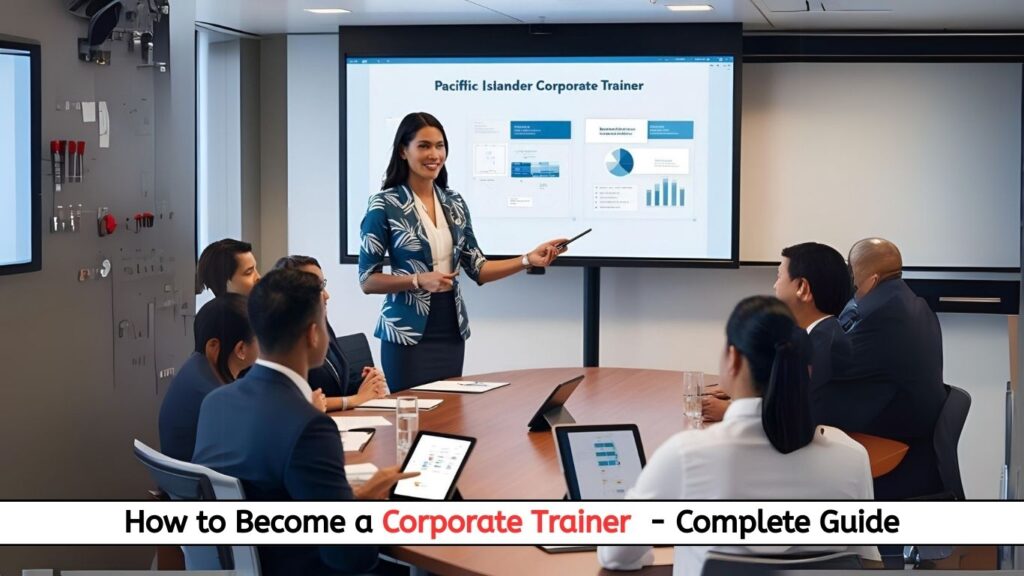
Introduction
In today’s fast-paced business world, companies invest heavily in employee development—and Corporate Trainers are at the heart of this growth. Whether training new hires, upskilling teams, or implementing leadership programs, these professionals boost productivity, engagement, and retention.
This comprehensive guide covers everything you need to know:
✅ History & Evolution of Corporate Training
✅ Salary Expectations (Entry-Level to Senior Roles)
✅ Key Roles & Responsibilities
✅ Must-Have Qualifications & Skills
✅ Step-by-Step Career Path
✅ Future Trends & Job Outlook
Let’s dive in!
1. The History of Corporate Training
Early Beginnings (1900s-1950s)
- 1910s-20s: Frederick Taylor’s “Scientific Management” introduced structured workplace training.
- WWII Era: The U.S. government’s “Training Within Industry” (TWI) program standardized job training.
The Rise of L&D (1960s-1990s)
- 1960s: Companies like IBM pioneered corporate universities.
- 1980s: The “Total Quality Management” (TQM) movement emphasized continuous training.
- 1990s: E-learning emerged with CD-ROMs and early LMS platforms.
Modern Era (2000s-Present)
- 2000s: Blended learning (online + in-person) became mainstream.
- 2010s: Microlearning, gamification, and mobile training gained traction.
- 2020s: AI-driven coaching, VR simulations, and personalized learning paths dominate.
Today, Corporate Trainers are strategic partners in employee development and business success.
2. Corporate Trainer Salary Expectations
Salaries vary by experience, industry, and location:
| Experience Level | Average Salary (Annual) |
|---|---|
| Entry-Level (0-2 yrs) | $45,000 – $60,000 |
| Mid-Level (3-7 yrs) | $60,000 – $85,000 |
| Senior-Level (8+ yrs) | $85,000 – $120,000+ |
| Freelance/Consulting | $50 – $150 per hour |
Top-Paying Industries
✔ Tech & IT ($70K – $110K)
✔ Finance & Banking ($65K – $100K)
✔ Healthcare & Pharma ($60K – $95K)
✔ Manufacturing & Logistics ($55K – $90K)
Note: Certifications (e.g., CPTD) and specialized skills (e.g., leadership development) increase earning potential.
3. Roles & Responsibilities of a Corporate Trainer
Corporate Trainers design, deliver, and evaluate training programs to enhance workforce skills.
A. Training Needs Analysis
- Identify skill gaps through surveys, performance data, and manager feedback.
- Align training with business goals (e.g., sales growth, compliance).
B. Curriculum Development
- Design engaging workshops, e-learning courses, and onboarding programs.
- Use ADDIE or SAM models for structured training development.
C. Training Delivery
- Conduct in-person, virtual, and hybrid sessions.
- Facilitate role-playing, simulations, and group discussions.
D. Evaluation & ROI Measurement
- Use Kirkpatrick’s Model to assess training effectiveness.
- Track employee performance improvements post-training.
E. Specialized Training Areas
- Soft Skills: Leadership, communication, teamwork.
- Technical Skills: Software, compliance, safety protocols.
- Diversity & Inclusion: Unconscious bias, cultural competency.
4. Qualifications & Skills Required
A. Educational Background
- Bachelor’s degree in HR, Education, Business, or Psychology (common but not mandatory).
- Certifications boost credibility:
- Certified Professional in Talent Development (CPTD)
- ATD Master Trainer™
- SHRM Certified Professional (SHRM-CP)
B. Technical Skills
✔ LMS Platforms (Workday, Cornerstone, TalentLMS)
✔ E-Learning Tools (Articulate 360, Adobe Captivate)
✔ Data Analytics (Measuring training effectiveness)
C. Soft Skills
✔ Public Speaking & Facilitation
✔ Active Listening & Empathy
✔ Adaptability (Handling different learning styles)
5. How to Get Started as a Corporate Trainer
Step 1: Gain Relevant Experience
- Start in HR, teaching, or customer service to build facilitation skills.
- Volunteer to train colleagues or new hires in your current job.
Step 2: Build a Portfolio
- Create sample training modules (onboarding, sales training, etc.).
- Record mock training sessions for demonstration.
Step 3: Get Certified (Optional but Valuable)
- ATD’s Associate Professional in Talent Development (APTD) for beginners.
- Dale Carnegie Training Certification for public speaking.
Step 4: Apply for Jobs
- Look for titles like:
- Corporate Training Specialist
- Learning & Development (L&D) Coordinator
- Technical Trainer
Step 5: Network & Stay Updated
- Join ATD, LinkedIn L&D groups.
- Attend training conferences (ATD ICE, Training Magazine Conference).
6. Future of Corporate Training
Emerging Trends
🚀 AI & Chatbots – Personalized coaching via AI (e.g., ChatGPT for Q&A).
🚀 VR/AR Training – Immersive simulations for high-risk jobs (healthcare, manufacturing).
🚀 Microlearning – Bite-sized training for busy employees.
🚀 Data-Driven L&D – Predictive analytics to tailor training.
Job Outlook
- 8% growth by 2030 (faster than average).
- High demand in tech, healthcare, and remote workforce training.
Final Thoughts: Is This Career Right for You?
Corporate training is ideal if you:
✓ Love teaching and public speaking
✓ Enjoy problem-solving and creativity
✓ Want to impact employee growth and business success
Pro Tip: Specialize in high-demand areas (DEI, cybersecurity, leadership development).
Ready to Start?
📌 Comment below for free resource recommendations!
📌 Share this guide with aspiring trainers!













Post Comment